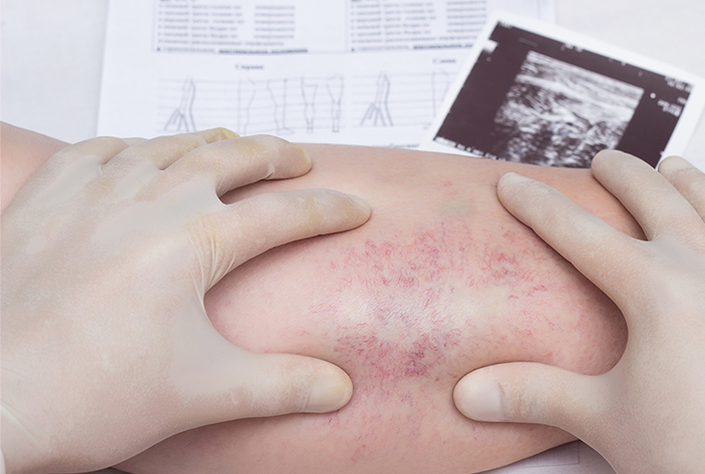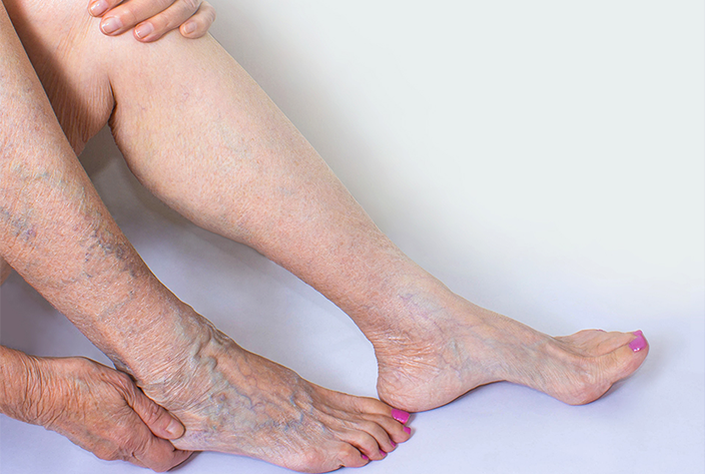

Varicose veins are common, affecting an estimated 3 in 10 adults. And for the most part, they’re just another part of the ageing process.
So if you’ve just noticed a new varicose vein on your legs, do you really need to worry?
After reading this guide, you’ll never have to worry about your varicose veins again. We’re going to break down everything you need to know about them, helping you to understand, diagnose, and determine the best course of treatment to help you live your best life.
Varicose veins are enlarged, twisted, or bulging veins that are visible under the surface of the skin. They’re most commonly found in the legs and feet and are caused by damaged damaged blood valves.
The movement of blood through your veins is facilitated by one-way valves, which prevent blood from travelling the wrong way. Varicose veins occur when these valves become damaged and unable to transport blood at a normal rate. As a result, blood pools and increases the pressure in the vein, causing it to varicose.
Varicose veins can occur in any superficial vein near the surface of your skin and primarily occur in older individuals. However, you’re more at risk if you:
Varicose veins don’t all look the same and symptoms often vary between individuals. However, these are the most common symptoms & warning signs that may indicate you have varicose veins:
If you’re experiencing any of these symptoms, contact us right away to schedule your varicose vein consultation.
It’s important to note that varicose veins are different from spider veins, another superficial vein issue. The terms are often used interchangeably but are in fact distinct from one another. Here's how to tell the difference between varicose veins and spider veins.
Varicose veins are much larger and more visible than spider veins. They present as bulging, twisted vein abnormalities that are easily visible near the surface of the skin. Alternatively, spider veins are smaller veins that present as fine lines just under the skin. They’re usually blue, red, or purple in colour and often form in web shapes, rather than just a singular vein like varicose veins.
Varicose veins are most often found in the legs. Spider veins can appear anywhere on the body but are most common on the face, legs, and ankles.
The root cause of varicose veins is damaged blood valves whereas spider veins can be caused by a variety of factors such as ageing, hormones, prolonged sun exposure, and genetics.
Varicose vein treatment typically involves non-surgical techniques like laser ablation or sclerotherapy, a procedure that redirects blood flow away from the damaged veins. Spider veins can also be removed with laser treatments.
You may have been led to believe that varicose veins are just a cosmetic issue. But damaged veins in the leg affect your body’s ability to circulate blood & nutrients to the heart and rest of the body. It’s important to treat varicose veins before they worsen and cause major health issues.

If you’ve only just noticed varicose veins appearing on your leg, we suggest wearing compression stockings or leg sleeves to improve blood circulation. This should slow the progression of varicose veins. In more serious cases, it’s recommended that you see a doctor immediately to have the veins treated and removed. Without treatment, the veins will continue to expand and potentially throw a blood clot.
If you leave varicose veins untreated for too long, you’ll likely experience health and cosmetic complications such as:
If you believe you may have a varicose vein, it’s best to evaluate and treat it early so that it does not cause more severe health issues.
How do I know if I have a blood clot in my varicose vein?
You may have a blood clot in your varicose vein if it’s more swollen than normal, increased pain & sensitivity, red & warm to the touch, or drastic changes in skin colour. Visit your doctor right away if you notice any of these symptoms to prevent any serious medical issues.
When are varicose veins serious?
Generally speaking, varicose veins are not that serious in the first few days and weeks after first appearing. In any case, you should have them examined to stay ahead of potential complications.
